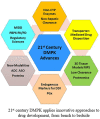Recent advances in the translation of drug metabolism and pharmacokinetics science for drug discovery and development
- PMID: 35755285
- PMCID: PMC9214059
- DOI: 10.1016/j.apsb.2022.03.009
Recent advances in the translation of drug metabolism and pharmacokinetics science for drug discovery and development
Abstract
Drug metabolism and pharmacokinetics (DMPK) is an important branch of pharmaceutical sciences. The nature of ADME (absorption, distribution, metabolism, excretion) and PK (pharmacokinetics) inquiries during drug discovery and development has evolved in recent years from being largely descriptive to seeking a more quantitative and mechanistic understanding of the fate of drug candidates in biological systems. Tremendous progress has been made in the past decade, not only in the characterization of physiochemical properties of drugs that influence their ADME, target organ exposure, and toxicity, but also in the identification of design principles that can minimize drug-drug interaction (DDI) potentials and reduce the attritions. The importance of membrane transporters in drug disposition, efficacy, and safety, as well as the interplay with metabolic processes, has been increasingly recognized. Dramatic increases in investments on new modalities beyond traditional small and large molecule drugs, such as peptides, oligonucleotides, and antibody-drug conjugates, necessitated further innovations in bioanalytical and experimental tools for the characterization of their ADME properties. In this review, we highlight some of the most notable advances in the last decade, and provide future perspectives on potential major breakthroughs and innovations in the translation of DMPK science in various stages of drug discovery and development.
Keywords: ADME; Biologics license application; Drug discovery and development; Micro-physiological systems; Model-informed drug development; New drug application; New modalities; Pharmacokinetics.
© 2022 Chinese Pharmaceutical Association and Institute of Materia Medica, Chinese Academy of Medical Sciences. Production and hosting by Elsevier B.V.
Conflict of interest statement
The views expressed are those of authors and do not necessarily reflect FDA's views or policy. The authors declare no conflicts of interest.
Figures




Similar articles
-
ADME of biologics-what have we learned from small molecules?AAPS J. 2012 Sep;14(3):410-9. doi: 10.1208/s12248-012-9353-6. Epub 2012 Apr 7. AAPS J. 2012. PMID: 22484625 Free PMC article. Review.
-
Metabolism and toxicity of drugs. Two decades of progress in industrial drug metabolism.Chem Res Toxicol. 2008 Jan;21(1):129-37. doi: 10.1021/tx7002273. Epub 2007 Dec 4. Chem Res Toxicol. 2008. PMID: 18052111 Review.
-
In Silico Absorption, Distribution, Metabolism, Excretion, and Pharmacokinetics (ADME-PK): Utility and Best Practices. An Industry Perspective from the International Consortium for Innovation through Quality in Pharmaceutical Development.J Med Chem. 2017 Nov 22;60(22):9097-9113. doi: 10.1021/acs.jmedchem.7b00487. Epub 2017 Jun 27. J Med Chem. 2017. PMID: 28609624 Review.
-
Progress in predicting human ADME parameters in silico.J Pharmacol Toxicol Methods. 2000 Jul-Aug;44(1):251-72. doi: 10.1016/s1056-8719(00)00109-x. J Pharmacol Toxicol Methods. 2000. PMID: 11274894 Review.
-
Factors Influencing ADME Properties of Therapeutic Antisense Oligonucleotides: Physicochemical Characteristics and Beyond.Curr Drug Metab. 2023;24(7):536-552. doi: 10.2174/1389200224666230418092626. Curr Drug Metab. 2023. PMID: 37076460
Cited by
-
Assessment of the in vitro anti-diabetic activity with molecular dynamic simulations of limonoids isolated from Adalia lemon peels.Sci Rep. 2024 Sep 14;14(1):21478. doi: 10.1038/s41598-024-71198-5. Sci Rep. 2024. PMID: 39277638 Free PMC article.
-
A Randomized, Open-Label, Phase I, Single-Dose Study of Antisense Oligonucleotide, Vupanorsen, in Chinese Adults with Elevated Triglycerides.Drugs R D. 2024 Jun;24(2):253-262. doi: 10.1007/s40268-024-00467-5. Epub 2024 Jul 1. Drugs R D. 2024. PMID: 38949758 Free PMC article. Clinical Trial.
-
Covalent targeted radioligands potentiate radionuclide therapy.Nature. 2024 Jun;630(8015):206-213. doi: 10.1038/s41586-024-07461-6. Epub 2024 May 22. Nature. 2024. PMID: 38778111
-
Clinical Insights on Caloric Restriction Mimetics for Mitigating Brain Aging and Related Neurodegeneration.Cell Mol Neurobiol. 2024 Oct 16;44(1):67. doi: 10.1007/s10571-024-01493-2. Cell Mol Neurobiol. 2024. PMID: 39412683 Free PMC article. Review.
-
Discovery of GluN2A subtype-selective N-methyl-d-aspartate (NMDA) receptor ligands.Acta Pharm Sin B. 2024 May;14(5):1987-2005. doi: 10.1016/j.apsb.2024.01.004. Epub 2024 Jan 10. Acta Pharm Sin B. 2024. PMID: 38799621 Free PMC article. Review.
References
-
- Chung T.D.Y., Terry D.B., Smith L.H. In: Assay guidance manual. Markossian S., Grossman A., Brimacombe K., Arkin M., Auld D., Austin C.P., et al., editors. Eli Lilly & Company and the National Center for Advancing Translational Sciences; Bethesda (MD): 2004–; 2015. In vitro and in vivo assessment of ADME and PK properties during lead selection and lead optimization—guidelines, benchmarks and rules of thumb. - PubMed
-
- Wood F.L., Houston J.B., Hallifax D. Clearance prediction methodology needs fundamental improvement: trends common to rat and human hepatocytes/microsomes and implications for experimental methodology. Drug Metab Dispos. 2017;45:1178–1188. - PubMed
-
- Saravanakumar A., Sadighi A., Ryu R., Akhlaghi F. Physicochemical properties, biotransformation, and transport pathways of established and newly approved medications: a systematic review of the top 200 most prescribed drugs vs. the FDA-approved drugs between 2005 and 2016. Clin Pharmacokinet. 2019;58:1281–1294. - PMC - PubMed
Publication types
Grants and funding
LinkOut - more resources
Full Text Sources
Miscellaneous

